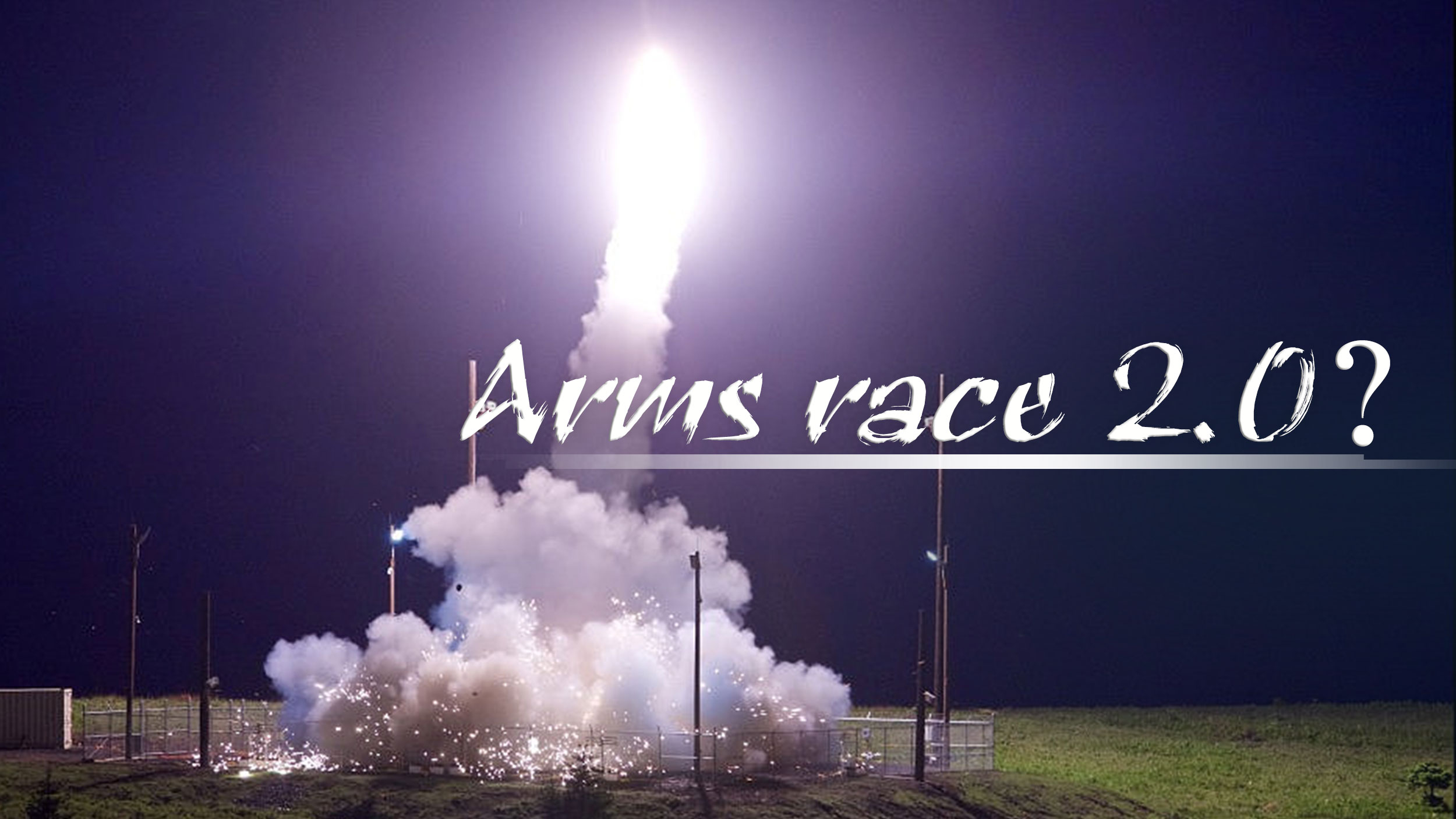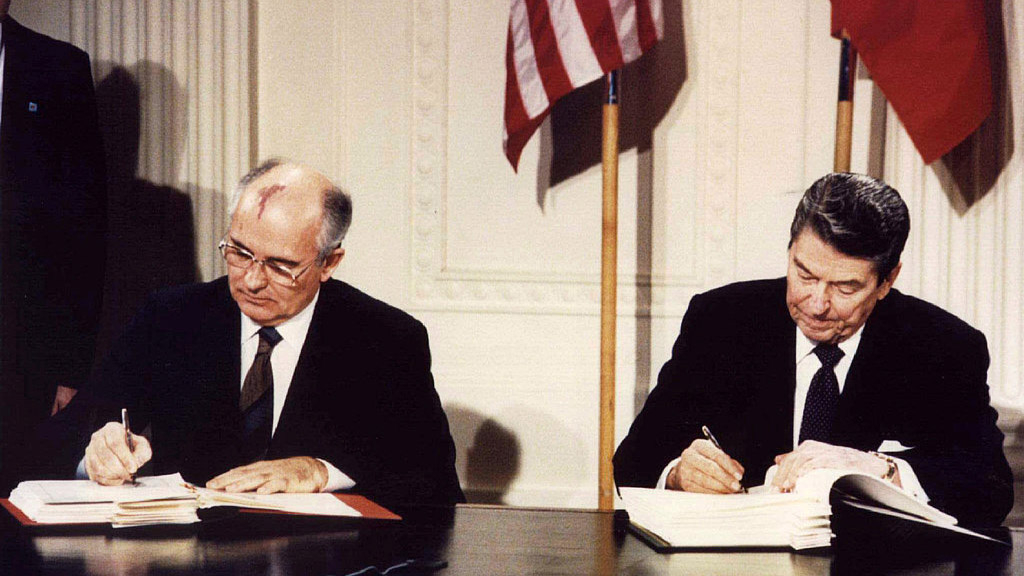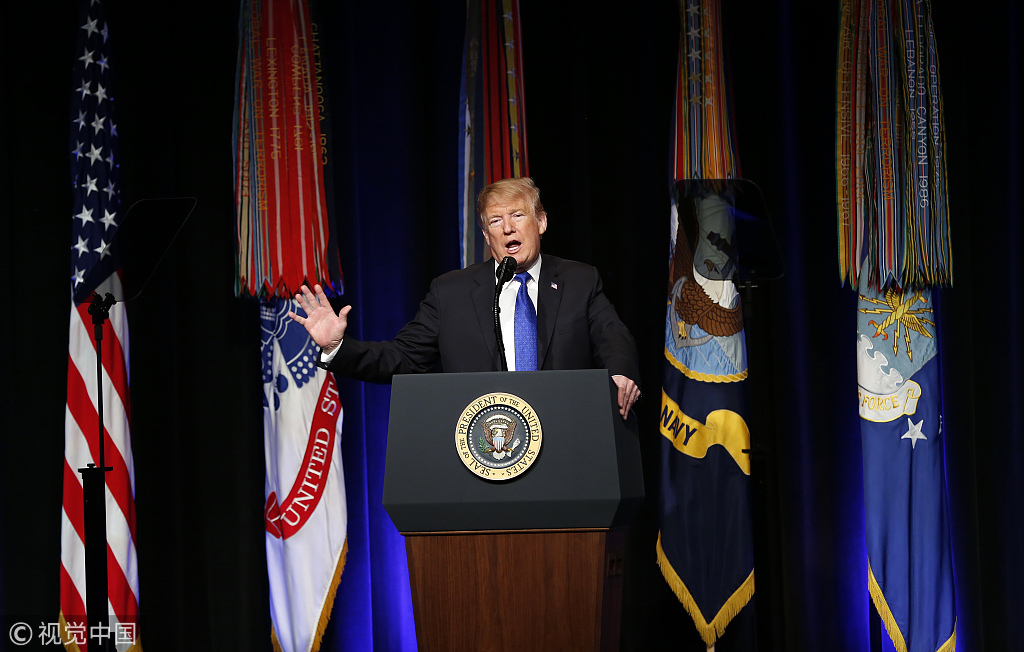
World
13:50, 31-Jan-2019
Is arms race 2.0 coming with INF Treaty in danger?
Updated
14:28, 31-Jan-2019
By Meng Yaping

The world could be standing on the verge of a new nuclear arms race as the United States now is set to start the six-month process of quitting the 1987 Intermediate-range Nuclear Forces Treaty (INF) on February 2, which is likely to be the latest accord Washington scraps.
Read more:
The U.S. accuses Russia of refusing to destroy the 9M729 missile system, which it claims violates the pact. Russia insists that the missile has a range shorter than the 500-5,500 kilometers stipulated by the deal and in turn accuses Washington of breaking the pact.
Experts are worried that the U.S. withdrawal of the treaty would put the whole world in an arms control crisis.
What is INF Treaty, and why is it important?
The Treaty between The United States of America and The Union of Soviet Socialist Republics on the Elimination of Their Intermediate-Range And Shorter-Range Missiles, is commonly referred to as the INF (Intermediate-Range Nuclear Forces) Treaty. For many years, the U.S. and Russia have been accusing each other of violating the INF Treaty, which was signed in 1987 by then-U.S. President Ronald Reagan and Soviet leader Mikhail Gorbachev on the elimination of intermediate-range and shorter-range missiles.
02:11

The Cold War-era pact aimed to help protect the security of the U.S. and its allies in Europe and the Far East. It prohibits the U.S. and Russia from possessing, producing or test-flying a ground-launched cruise missile with a range of 500 to 5,500 kilometers. The treaty did not cover sea-launched missiles.
The INF Treaty marked the first time the two Cold War superpowers agreed to reduce their nuclear arsenals, eliminate an entire category of nuclear weapons, and utilize extensive on-site inspections for verification.
As a result, the U.S. and the former Soviet Union destroyed a total of 2,692 short and medium-range missiles by the treaty's implemented deadline – June 1, 1991. It also led to an end to a dangerous standoff between U.S. Pershing and cruise missiles and Soviet SS-20 missiles in Europe.

The 9M729 missile demonstrated after a briefing for military attaches and international media by the Russian Defense Ministry at the Patriot Congress and Exhibition Centre in Kubinka, Moscow Region, on the 9M729 missile system. /VCG Photo
The 9M729 missile demonstrated after a briefing for military attaches and international media by the Russian Defense Ministry at the Patriot Congress and Exhibition Centre in Kubinka, Moscow Region, on the 9M729 missile system. /VCG Photo
What does the U.S. want?
Experts say the U.S. seeks to gain more from quitting the deal.
"Russia is not the major reason of U.S. decision to withdraw from the treaty; the United States itself is," said Li Bin, a senior fellow of Nuclear Policy Program at the Carnegie Endowment for International Peace, in a Xinhua report.
Li said some people in the U.S. believe that "no other country could prevail against the United States in an arms race" without the agreements.
As far back as 2013, Pentagon was considering various technologies that the U.S. could develop should Washington walk away from the INF Treaty, according to U.S. media reports.

U.S. President Donald Trump participates in a Missile Defense Review announcement at the Pentagon, in Arlington, VA, U.S., January 17, 2019. /VCG Photo
U.S. President Donald Trump participates in a Missile Defense Review announcement at the Pentagon, in Arlington, VA, U.S., January 17, 2019. /VCG Photo
Russian President Vladimir Putin said last December that the U.S. Congress allocated money for the development of missiles banned by the treaty even before Washington announced its withdrawal from the pact.
The abandonment of the deal would also arouse speculation on whether the U.S. would develop and deploy ground-based intermediate-range missiles in the near future.
Is China to blame for the collapse of the treaty?
U.S. President Donald Trump said that the U.S. will have to develop those weapons unless Russia and China are committed to stopping the development process. And U.S. Secretary of State Mike Pompeo also cited China, which is not a party to the treaty, as a reason why the agreement no longer makes sense for the U.S., which implies that the U.S. sees benefits to withdrawal from the treaty beyond its concerns about Russia's noncompliance.
The Chinese Foreign Ministry slammed the remarks, saying it's completely wrong to link the U.S. withdrawal from the treaty to China and warned that the unilateral withdrawal from the treaty will cause negative impacts in various areas.
What are the possible consequences after U.S. withdrawal?
Arms race 2.0?
If the U.S. makes the declaration of exit into a reality, Washington will be able to deploy intermediate and land-based cruise missile in Europe and Middle-East. This will directly threaten Moscow and Ural in Russia. Japan, South Korea and Guam are also potential places for U.S. deployment, threatening the Far East of Russia and China's eastern and central areas. And this will force Moscow to increase the survivability of its nuclear forces.
This multidimensional arms race would most likely become multilateral, drawing in China, NATO member-states, India, Pakistan, Israel, and the Democratic People's Republic of Korea (DPRK). Plus, the consequent and inevitable proliferation of nuclear weapons will be concentrated along Russia's borders, leaving Iran, Turkey, Egypt, Saudi Arabia, South Korea, and Japan forced to ensure their own security, analyzed Alexey Arbatov, head of the Center for International Security at the Primakov National Research Institute of World Economy and International Relations.
Alarm in Europe
The end of the INF Treaty would also cause an alarm in Europe, since the U.S. allies on the continent would be situated right between Russian and U.S. intermediate-range nuclear missiles.
The issue will only grow as Russia builds up its intermediate-range missiles on its western border and the U.S. responds with its own buildup in Europe. Countries such as Germany are likely to oppose U.S. deployments of such missiles in their territory, but other countries such as Poland and Romania could be more willing to house these missile units, especially if they guarantee an added U.S. military presence in their territory, commented an article by Stratfor Worldview, a U.S. based think tank.
Jeopardize other treaties
The U.S. withdrawal from the INF Treaty risks triggering a chain reaction that would result in the collapse of the U.S.-Russia nuclear arms control architecture, including the falling of the 2010 New Strategic Arms Reductions Treaty (New START) between Washington and Moscow, the Non-Proliferation Treaty (NPT), and the Comprehensive Nuclear-Test-Ban Treaty (CTBT).
Breaking arms control agreements was much easier than concluding them, said Arbatov.
"But history shows that rejecting arms control agreements never improves one's security and always damages it," added the expert.

SITEMAP
Copyright © 2018 CGTN. Beijing ICP prepared NO.16065310-3
Copyright © 2018 CGTN. Beijing ICP prepared NO.16065310-3